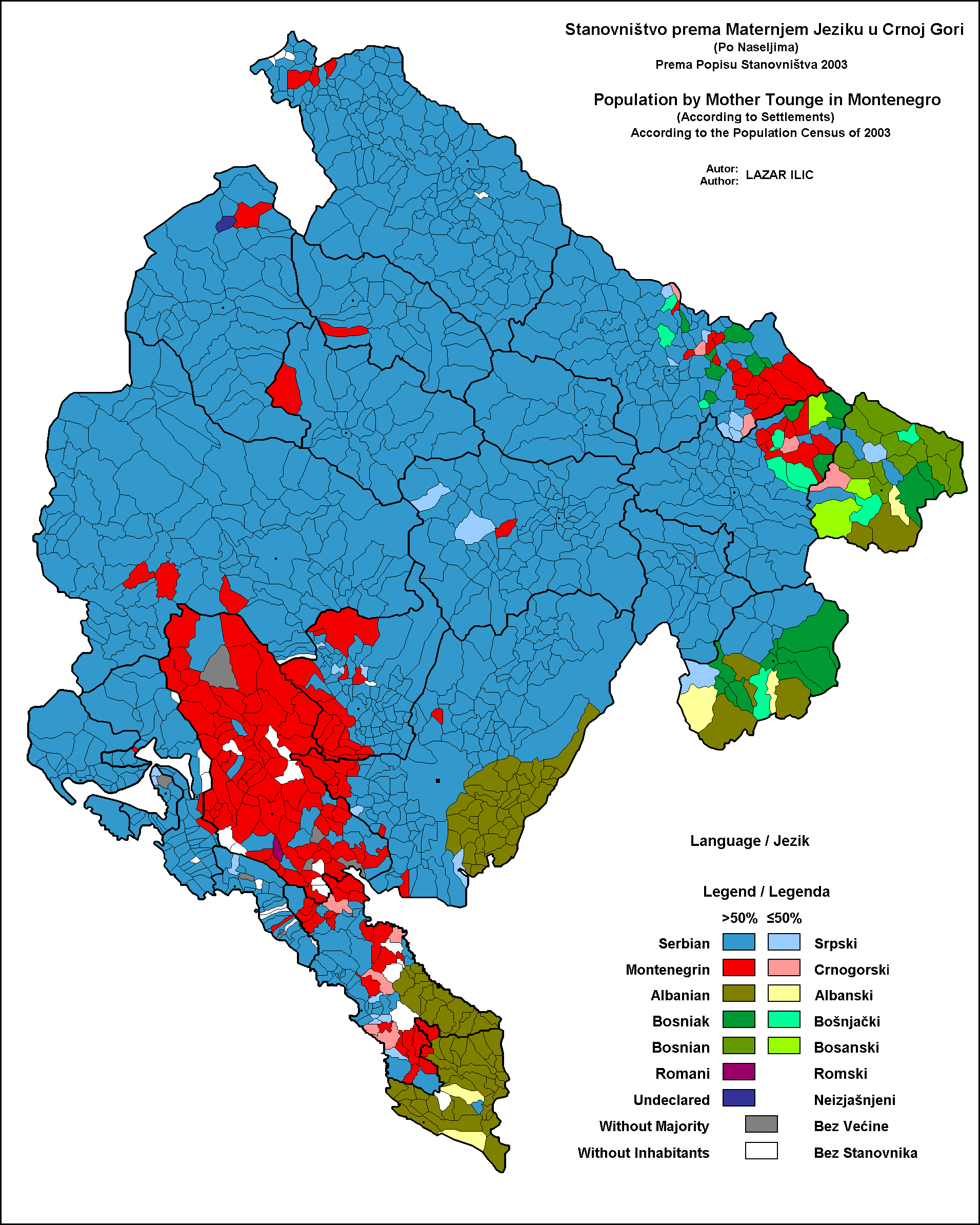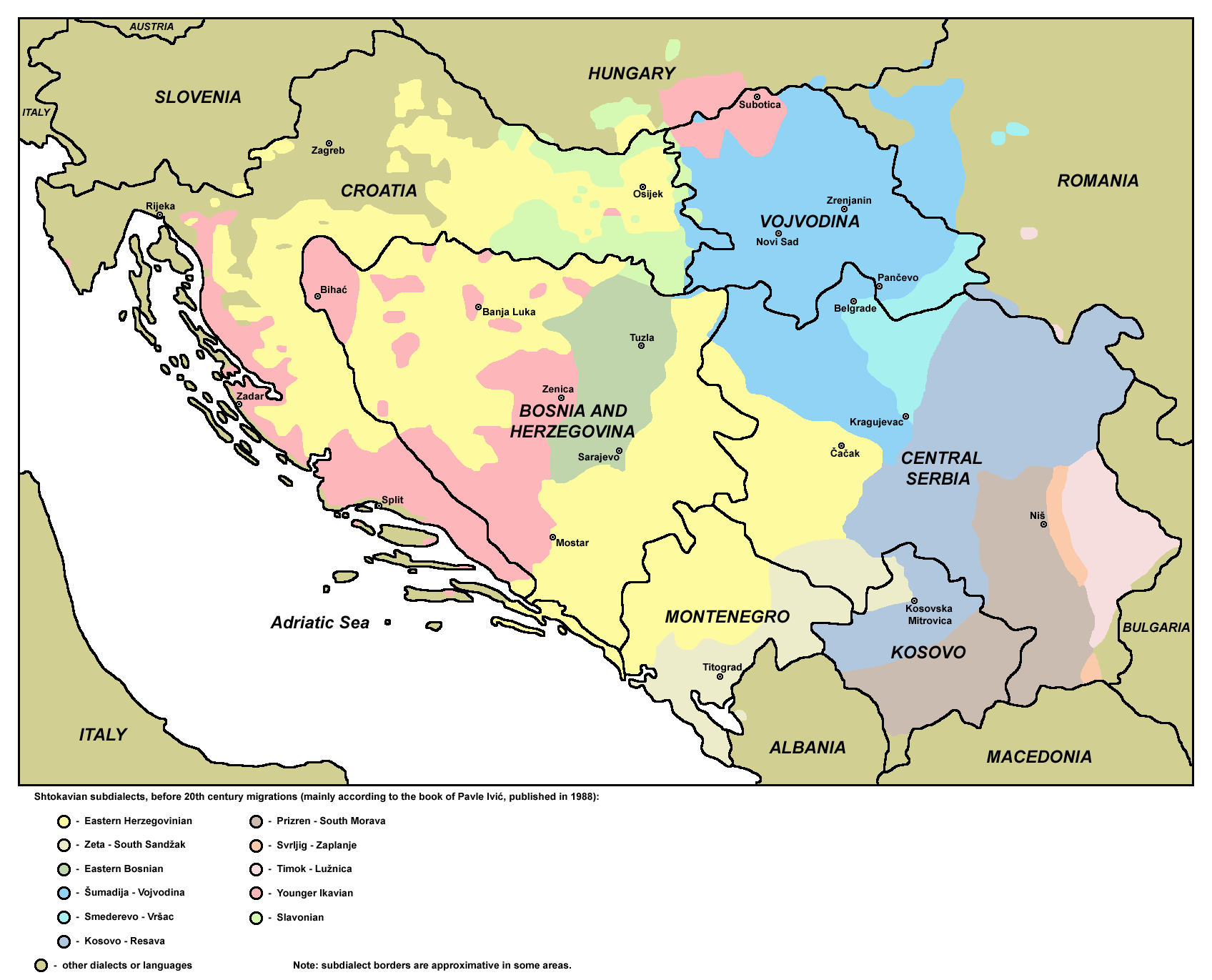|
Languages Of Montenegro
Languages of Montenegro are languages that are spoken in Montenegro. According to the Constitution of Montenegro, adopted in 2007, Montenegro has only one official language, specified as Montenegrin. However, at the 2011 census, 42% of the population declared Serbian to be their native language, while Montenegrin was the second most common at 37%. Both Montenegrin and Serbian are standardized varieties of the Serbo-Croatian language, alongside Bosnian and Croatian. However, an official standard for Montenegrin is still in the process of being formulated. The Montenegrin language is written in the Latin and Cyrillic alphabets, but there is a growing political movement to use only the Latin alphabet. Legally recognized minority languages are Albanian, Bosnian, and Croatian. As of 2017, Albanian is an official language of the municipalities of Podgorica, Ulcinj, Bar, Pljevlja, Rozaje and Tuzi. Additionally, there are a few hundred Italians in Montenegro, concentrated in the ... [...More Info...] [...Related Items...] OR: [Wikipedia] [Google] [Baidu] |
Montenegrin Language
Montenegrin ( ; cnr, label=none, / ) is a normative variety of the Serbo-Croatian language mainly used by Montenegrins and is the official language of Montenegro. Montenegrin is based on the most widespread dialect of Serbo-Croatian, Shtokavian, more specifically on Eastern Herzegovinian, which is also the basis of Standard Croatian, Serbian, and Bosnian. Montenegro's language has historically and traditionally been called either Serbian or Montenegrin. The idea of a standardized Montenegrin standard language separate from Serbian appeared in the 1990s during the breakup of Yugoslavia, through proponents of Montenegrin independence from the State Union of Serbia and Montenegro. Montenegrin became the official language of Montenegro with the ratification of a new constitution on 22 October 2007. Language standardization In January 2008, the government of Montenegro formed the Board (Council) for Standardization of the Montenegrin Language, which aims to standardize the ... [...More Info...] [...Related Items...] OR: [Wikipedia] [Google] [Baidu] |
Podgorica
Podgorica (Cyrillic script, Cyrillic: Подгорица, ; Literal translation, lit. 'under the hill') is the Capital city, capital and List of cities and towns in Montenegro, largest city of Montenegro. The city was formerly known as Titograd (Cyrillic script, Cyrillic: Титоград, ) between 1946 and 1992—in the period that Montenegro formed, as the Socialist Republic of Montenegro in honour of Marshal of Yugoslavia, Marshal Josip Broz Tito. The city was largely destroyed during the bombing of Podgorica in World War II and accordingly the city is now dominated by architecture from the following decades of communism. Further but less substantial damage was caused by the NATO bombing of Yugoslavia, 1999 bombing by NATO forces. The surrounding landscape is predominantly Mountain range, mountainous terrain. The city is just north of the Lake Skadar and close to coastal destinations on the Adriatic Sea. Historically, it was Podgorica's position at the confluence of the Ribn ... [...More Info...] [...Related Items...] OR: [Wikipedia] [Google] [Baidu] |
Eastern Herzegovinian Dialect
The Eastern Herzegovinian dialect (, Serbo-Croatian: ''istočnohercegovački'' / источнохерцеговачки) is the most widespread subdialect of the Shtokavian dialect of Serbo-Croatian, both by territory and the number of speakers. It is the dialectal basis for all modern literary Serbo-Croatian standards: Bosnian, Croatian, Serbian, and Montenegrin (the latter only partially codified). Distribution It covers large areas of Croatia, Bosnia-Herzegovina, Serbia and Montenegro. It is also spoken in four villages in White Carniola, Slovenia ( Miliči, Bojanci, Marindol and Paunoviči), the inhabitants of which are descendants of Uskoks. It is composed of two larger zones that are territorially separated: * Southeastern zone, where it originated from (eastern Herzegovina, western Montenegro, western Serbia, eastern Bosnia, Posavinan Podrinje) * Northwestern zone (western and northwestern Bosnia, northern Dalmatia with Gorski Kotar, narrower strips of Croatia, parts ... [...More Info...] [...Related Items...] OR: [Wikipedia] [Google] [Baidu] |
Montenegrin Dialects
The dialects of Serbo-Croatian include the vernacular forms of Serbo-Croatian as a whole or as part of its standard varieties: Bosnian, Croatian, Montenegrin and Serbian. They are part of the dialect continuum of South Slavic languages that joins the Macedonian dialects to the south, Bulgarian dialects to the southeast and Slovene dialects to the northwest.Matasović 2008 The division of South Slavic dialects to "Slovene", "Serbo-Croatian", "Macedonian" and "Bulgarian" is mostly based on political grounds: for example all dialects within modern Slovenia are classified as "Slovene", despite some of them historically originating from other regions, while all dialects in modern Croatia are classified as "Croatian" (or "Serbo-Croatian" before 1990) despite not forming a coherent linguistic entity (and some are proven to originate from parts of what is today Slovenia). Therefore, "Serbo-Croatian dialects" are simply South Slavic dialects in countries where a variant of Serbo-Croa ... [...More Info...] [...Related Items...] OR: [Wikipedia] [Google] [Baidu] |
Youth Initiative For Human Rights
__NOTOC__ The Youth Initiative for Human Rights ( sh, Inicijativa mladih za ljudska prava; sq, Nisma e të Rinjve për të Drejtat e Njeriut) or YIHR is a network of autonomous non-governmental organization active in Serbia, Kosovo, Croatia, Montenegro and Bosnia and Herzegovina. It is focused on building connections and establishing cooperation between young people from different ethnic groups in Balkans. YIHR supported the work of the International Criminal Tribunal for the former Yugoslavia (ICTY) through information dissemination and education and monitoring of human rights. It also organizes visits to the International Commission on Missing Persons. In 2008 Croatian branch of the organization was established which led to transformation of national offices/programs into autonomous organizations that established a regional YIHR Regional Network in 2010. On 25 September 2013 the European Court of Human Rights delivered the judgment in the case of ''Youth Initiative for Human R ... [...More Info...] [...Related Items...] OR: [Wikipedia] [Google] [Baidu] |
Council Of Europe
The Council of Europe (CoE; french: Conseil de l'Europe, ) is an international organisation founded in the wake of World War II to uphold European Convention on Human Rights, human rights, democracy and the Law in Europe, rule of law in Europe. Founded in 1949, it has 46 member states, with a population of approximately 675 million; it operates with an annual budget of approximately 500 million euros. The organisation is distinct from the European Union (EU), although it is sometimes confused with it, partly because the EU has adopted the original Flag of Europe, European flag, created for the Council of Europe in 1955, as well as the Anthem of Europe, European anthem. No country has ever joined the EU without first belonging to the Council of Europe. The Council of Europe is an official United Nations General Assembly observers, United Nations Observer. Being an international organization, the Council of Europe cannot make laws, but it does have the ability to push for the enf ... [...More Info...] [...Related Items...] OR: [Wikipedia] [Google] [Baidu] |
Serbia And Montenegro
Serbia and Montenegro ( sr, Cрбија и Црна Гора, translit=Srbija i Crna Gora) was a country in Southeast Europe located in the Balkans that existed from 1992 to 2006, following the breakup of the Socialist Federal Republic of Yugoslavia (SFR Yugoslavia) which bordered Hungary to the north, Romania to the northeast, Bulgaria to the southeast, Macedonia to the south, Croatia and Bosnia and Herzegovina to the west, and Albania to the southwest. The state was founded on 27 April 1992 as the Federal Republic of Yugoslavia, known as FR Yugoslavia or simply Yugoslavia which comprised the Republic of Serbia and the Republic of Montenegro. In February 2003, FR Yugoslavia was transformed from a federal republic to a political union until Montenegro seceded from the union in June 2006, leading to the full independence of both Serbia and Montenegro. Its aspirations to be the sole legal successor state to SFR Yugoslavia were not recognized by the United Nations, following t ... [...More Info...] [...Related Items...] OR: [Wikipedia] [Google] [Baidu] |
European Charter For Regional Or Minority Languages
The European Charter for Regional or Minority Languages (ECRML) is a European treaty (CETS 148) adopted in 1992 under the auspices of the Council of Europe to protect and promote historical regional and minority languages in Europe. However, the charter does not provide any criterion or definition for an idiom to be a minority or a regional language, and the classification stays in the hands of the national state. The preparation for the charter was undertaken by the predecessor to the current Congress of Local and Regional Authorities, the Standing Conference of Local and Regional Authorities of Europe because involvement of local and regional government was essential. The actual charter was written in the Parliamentary Assembly based on the Congress' Recommendations. It only applies to languages traditionally used by the nationals of the State Parties (thus excluding languages used by recent immigrants from other states, see immigrant languages), which significantly differ fro ... [...More Info...] [...Related Items...] OR: [Wikipedia] [Google] [Baidu] |
Bay Of Kotor
The Bay of Kotor ( Montenegrin and Serbian: , Italian: ), also known as the Boka, is a winding bay of the Adriatic Sea in southwestern Montenegro and the region of Montenegro concentrated around the bay. It is also the southernmost part of the historical region of Dalmatia. The bay has been inhabited since antiquity. Its well-preserved medieval towns of Kotor, Risan, Tivat, Perast, Prčanj and Herceg Novi, along with their natural surroundings, are major tourist attractions. The Natural and Culturo-Historical Region of Kotor was designated a UNESCO World Heritage Site in 1979. Its numerous Orthodox and Catholic churches and monasteries attract numerous religious pilgrims and other visitors. Geography The bay is about long with a shoreline extending . It is surrounded by two massifs of the Dinaric Alps: the Orjen mountains to the west, and the Lovćen mountains to the east. The narrowest section of the bay, the long Verige Strait, is only wide at its narrowest point. The bay ... [...More Info...] [...Related Items...] OR: [Wikipedia] [Google] [Baidu] |
Tuzi
Tuzi ( cnr, Tuzi/Тузи, ; sq, Tuz or ''Tuzi'') is a small town in Montenegro and the seat of Tuzi Municipality, Montenegro. It is located along a main road between the city of Podgorica and the Albanian border crossing, just a few kilometers north of Lake Skadar. The Church of St. Anthony and Qazimbeg's Mosque are located in the centre of the town. Tuzi is the newest municipality in Montenegro, having been an independent municipality since 1 September 2018. Geography Tuzi is situated to the northwest of Lake Shkodra, 10 km from Podgorica, 150 km from Dubrovnik (Croatia) and 130 km to Tirana (Albania). It is surrounded by forests and mountains that are further connected with the Accursed Mountains. History The town of Tuzi is situated in Southeastern Montenegro, between Podgorica and the Skadar lake. The Albanian community of Tuzi descend from the surrounding tribes of Hoti, Gruda, Trieshi and Koja, which are part of the Malësor tribes. Tuzi was mentioned ... [...More Info...] [...Related Items...] OR: [Wikipedia] [Google] [Baidu] |




